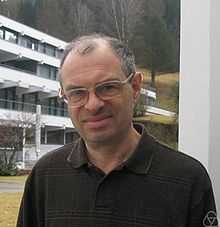Victor Ginzburg
| Victor Ginzburg | |
|---|---|
 | |
| Born |
1957 (age 57–58) Moscow, Russia |
| Nationality | American |
| Fields | Mathematics |
| Institutions | University of Chicago |
| Alma mater | Moscow State University |
| Doctoral advisor |
Alexandre Kirillov Israel Gelfand |
| Doctoral students |
Vladimir Baranovsky Wee Liang Gan Nicolas Guay Travis Schedler |
| Known for |
Ginzburg dg algebra Koszul duality |
Victor Ginzburg (born 1957) is a Russian American mathematician who works in representation theory and in noncommutative geometry. He is known for his contributions to geometric representation theory, especially, for his works on representations of quantum groups and Hecke algebras, and on the geometric Langlands program (Satake equivalence of categories). The book "Representation theory and complex geometry", by Chriss and Ginzburg, is nowadays a classical text on geometric representation theory. In an influential paper by Beilinson, Ginzburg, and Soergel, the authors introduced the concept of Koszul duality (cf. Koszul algebra) and the technique of "mixed categories" to representation theory. Ginzburg and Kapranov developed Koszul duality theory for operads.
In noncommutative geometry, Ginzburg defined, following earlier ideas of Kontsevich, the notion of Calabi-Yau algebra. An important role in the theory of motivic Donaldson-Thomas invariants is played by the so-called "Ginzburg dg algebra", a Calabi-Yau (dg)-algebra of dimension 3 associated with any cyclic potential on the path algebra of a quiver.
Ginzburg received his Ph.D. at Moscow State University in 1985, under the direction of Alexandre Kirillov and Israel Gelfand. He is currently a Professor of Mathematics at the University of Chicago.[1][2]
Selected publications
- ———; Chriss, N. (1997), Representation theory and complex geometry, Boston: Birkhäuser.
- ———; Kapranov, M. (1994), "Koszul duality for operads", Duke Math. J. 76: 203–272, arXiv:0709.1228, doi:10.1215/s0012-7094-94-07608-4.
- ———; Beilinson, A.; Soergel, W. (1996), "Koszul duality patterns in representation theory" (PDF), J. Amer. Math. Soc. 9: 473–527.
- ——— (2005). "Lectures on Noncommutative Geometry". arXiv:math/0506603..
- ———; Etingof, E. (2002), "Symplectic reflection algebras, Calogero-Moser space, and deformed Harish-Chandra homomorphism", Invent. Mathem. 147: 243–348, arXiv:math/0011114.
- ——— (2006). "Calabi-Yau Algebras". arXiv:math/0612139..
References
- ↑ Koppes, Steve (June 8, 2006), "Victor Ginzburg, Professor in Mathematics and the College", The University of Chicago Chronicle.
- ↑ http://www.ams.org/distribution/mmj/vol7-4-2007/ginzburg-birthday.html
External links
| Wikimedia Commons has media related to Victor Ginzburg. |
|